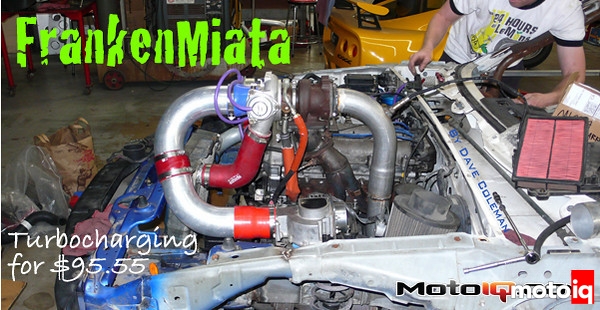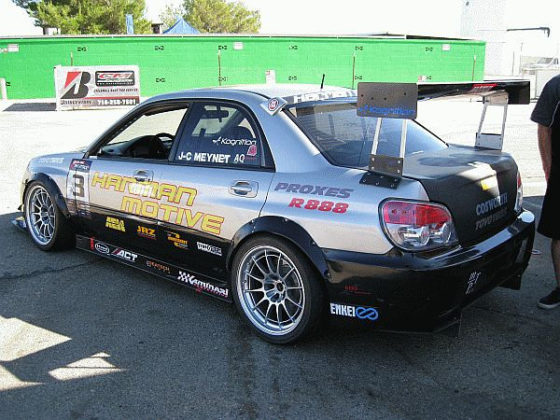,
Tuning
Now, as any wannabe turbo genius knows, forced induction will drastically increase combustion pressure and temperatures. When we’re on boost, we’ll need to run richer than a naturally-aspirated engine to keep combustion temperatures down, and retard timing to avoid detonation.
This tuning is usually the difference between a good turbo kit and blown motor. With almost no money to spend, good tuning was out of the question. Instead, we fell back on decades-old obsolete halfassery and made it reliable through the careful application of restraint.
Getting more fuel
Rising rate fuel pressure regulators used to be the standard tuning tool of the forced induction aftermarket. By increasing fuel pressure as some multiple of manifold pressure, these regulators (optimistically called Fuel Management Units back in the day) manage to squeeze something close to enough extra fuel through the stock injectors without the ECU ever getting involved.
 | |
| That little blue thing on the firewall is how pre-digital humans “tuned” engines when they added boost. |
These days, anyone interested in respectable levels of performance, reliability and drivability, of course, uses bigger injectors and relatively affordable programmable engine management to achieve the same thing with much greater precision and consistency, meaning FMUs are now little more than archeological oddities. Putting out the call on Miataturbo.net, we had a used FMU in our hands in less than a week for $20 in shipping.
Asking a 15-year old fuel pump from a 116-hp car to deliver both the extra fuel and the extra pressure an FMU requires is probably asking too much. Luckily for us, our car was so stripped when we got it that it didn’t even have a fuel pump. The tank, in fact, had been open to the elements (well, Southern California elements…) for months. After cleaning the dirt and leaves from the bottom of our tank, we rummaged around under some workbenches at MD Automotive and found a fuel pump that looked pretty big. Mark said it was probably from an Integra. Since they made over 170 hp, we figured it would be enough. In a perfect world, where we would actually go to the junkyard for a pump, something from a turbocharged car would be better, since they’re designed to deliver higher pressure to keep a constant pressure drop from the fuel rail to the boosted intake manifold. Our world is anything but perfect.
Since high fuel pressure stresses the pump and increases the odds of a fuel hose letting go, we wanted to meet our fuel needs with as little fuel pressure as possible. A simple trick to bump fuel output is to use injectors from the ever-so-slightly-more-powerful 1.8 Miata. The injectors are only slightly larger, so the ECU can correct for them in closed-loop conditions like idle and light cruise. In open-loop conditions, where we’ll be on boost anyway, they’ll deliver slightly more fuel. They are also allegedly free at any gank-a-park junkyard, since they fit in your pocket.
 | |
| The only part still attached to our Miata shell when we got it, aside from the shattered windshield, was the fuel tank. Naturally, the top of the tank was open to the elements and had been for months. |
The only way this benefits us at all, of course, is if we are able to adjust the fuel pressure lower as a result of the slightly higher flow. Turns out FMUs are still available new, as are different diaphragms that deliver different ratios of fuel pressure to manifold pressure. 8:1, 10:1, and 12:1 are the most common, and we had no idea what ours was. Still, if ours was 10:1 and the bigger injectors let us run an 8:1, they would be worthwhile. On the other hand, new diaphragms are more than $100, and since they aren’t durable enough to survive life under a workbench if they aren’t safely inside an FMU, nobody was volunteering to sell us any for $20.
Only testing would tell if we needed to buy a different diaphragm, if the injectors had helped, or if any of this was a good idea.
Let’s get retarded.
Retarding timing on boost seemed like a bigger challenge than delivering fuel. There is no widespread obsolete technology to fall back on. Or at least nothing that we could remember. Another plea on Miataturbo.net and we were reminded of the Bipes ACU. Ok, reminded isn’t the right word, because I’d never heard of such a thing. Turns out the Bipes was a magic little box that could retard timing based on airflow, intake air temperature, coolant temperature, manifold pressure, or some combination of those things.
Sounds sophisticated and expensive, no? Well get this: you tune it by flipping dip switches on the back of the box, and it talks to you with flashing LEDs. Crude, simple, brilliant, obsolete. In a word, perfect. Another $20 and we had used one.
Making the Bipes retard timing based on boost means telling it when you have boost. Since Miatas don’t have MAP sensors, the Bipes is designed to use a GM sensor. We found one in a Pontiac Sunbird Turbo at the gank-a-part. It’s also pocket sized.
Testing
So, fuel and timing handled. Time to race, no? No. Time to test. It’s easy to assume, now, looking back on a few trouble-free races, that this whole thing will work, but at the time it all seemed so improbable. We were scared, and engineers add instrumentation in direct proportion with their level of fear.
First, we bolted on the manifold right-side up and ran the car naturally aspirated to make sure our freebuild had been successful. Strapping it to MD Automotive’s Dynojet, our fresh old engine ripped off 100 hp to the wheels. This is actually unusually strong for a 1.6 Miata, but makes sense considering the fresh piston rings give good compression, while the loose tolerances everywhere else reduce internal friction.
Bolting the turbo on, we temporarily installed a K-type thermocouple just before the turbo and a wideband O2 sensor just after it. Location on these parts is critical. The thermocouple needs to measure exhaust temperature as close to the exhaust port as is practical so it can give you some idea of actual combustion temperatures. Turbos, by design, remove a lot of energy from the exhaust. Heat is energy, so measuring exhaust temps after the turbo is borderline useless.
| This is datalogging on the cheap. Put all your gauges in one place, take a video, then hope you can read them on playback. On the left, the analog gauge shows we’re hovering around 70 psi fuel pressure at full boost. On the screen, the right gauge shows boost pressure, which is bouncing from 3.5 to 4 psi. Along the bottom, and in the middle, is our air/fuel ratio, which seems slightly lean for a boosted engine, but most of our boosted rules of thumb are based on real boost, not this pissant 3.5 psi crap. The voltmeter is reading exhaust temperature in celsius, which is staying below 900 even with this abuse. That means this air/fuel ratio is fine. |
Wideband O2 sensors, on the other hand, need to have a relatively low pressure difference between the sensor and the outside world. Backpressure upstream of the turbo is high enough to significantly alter a wideband’s reading, also making it useless.
We also hooked up the dyno’s boost sensor, since we had no boost gauge on the car, and tee’d an analog fuel pressure gauge into the fuel line in hopes of figuring out what kind of FMU we had.After a few timid part-throttle passes listening for detonation, we finally buried the pedal and watched in horror as our little creation ripped off 170 hp on 7 psi of boost, pegging the 100-psi fuel pressure gauge in the process.
Shock, horror, giddy satisfaction and abject terror had a bus fight on the way to our heads. Abject terror won the fight. There was no way the car would survive 14 hours of racing at this power level. It would overheat, throw a rod, melt a piston, ping its ring lands into oblivion, and overheat some more. Then the fuel lines would explode and we’d all burn to death.
 | |
| Our first track test was a festival of data. Coolant temp on top, Air/fuel in the black box, EGT on the volt meter, and the black box with green LEDs is the Bipes. Each LED is 2 degrees of retard. Its a wonder we stayed on the track. |
This is that restraint thing I mentioned earlier. With modern engine management, this power level is fine. Downright tame, even. Even with our archaic techniques, we could probably get away with this on a street car. Street cars see relatively little full-throttle time, and the faster they are, the less time they spend wide open. You simply can’t keep your foot down without flying off the road. But we had every intention of flogging this engine relentlessly for days at a time. It had to be perfectly stable and comfortable at its peak power output. We immediately started trying to figure out how to make less boost.
 | |
| JayKav (just one name, like Bono), one of our three turbo engineers, reduced danerous horsepower by improving wastegate flow. |
The next day, we replaced every fuel hose in the car with the most expensive stuff we could find. Safety equipment is not included in the $500 limit for LeMons, and non-leaking fuel lines clearly count as safety.
Next, we took a die grinder to the wastegate port, slightly enlarging the opening and, more importantly, radiusing the leading edge of the wastegate hole to encourage exhaust flow to go out the open wastegate rather than continuing through to the turbine. If would be nice if we had taken a picture of the port, but we weren’t that smart. Anyway, it worked. On our next pull, boost fluctuated between 3.5 and 4 psi. Power was a much more survivable 140 hp. Fuel pressure stayed on the gauge.
Surprisingly, very few adjustments were needed after this. The air/fuel ratio seemed just a hair on the lean side of reasonable, hanging around 12.5:1, and the exhaust temperature (which is ultimately more important than air/fuel) was staying below 900 degrees C, a proven safe level.
We tweaked the Bipes a little, eventually setting it to retard 1 degree of timing for every psi of boost, then set the base timing 2 degrees advanced from stock in an effort to get better off-boost throttle response and better fuel economy during yellow flags. Had we not found such a good deal on a Bipes, we easily could have run with no aftermarket timing control and just set the base timing 2 degrees retarded. That would put us in the same place at full boost and only sacrifice a little bit of responsiveness down low.
 |
| The power is nice, but the width of the powerband is astonishing. A torque plateau from 2500 rpm to 7000 rpm makes the Frankenmiata incredibly easy to drive. |
Track abuse
| Our first actual track test went better than we ever could have imagined. Better than those Honda guys in front of us could have imagined, either… Road/Race Engineering loaned us a GoPro camera to document the success. |
Transient conditions like a dyno pull aren’t really the same as lapping a track, or a long, hard pull down a straight. Typically, exhaust temperatures run quite a bit higher on the track than they do on a quick dyno pull. To get a better idea of how high our exhaust temperatures would go in those more grueling conditions, we put the car in 4th gear, spun the dyno to redline, then used the dyno brake to drag the engine back down to 5000 rpm and accelerated again and again to redline. Even with this abuse, exhaust temps stayed in check. We were ready for the track.
Before you take a Lemon to a track day, it’s best to call ahead and warn them. We called Speed Ventures, explained slowly and carefully, and were shocked no to be turned away. We were equally shocked that the engine performed flawlessly, except for that funny noise…
More on that another day.





